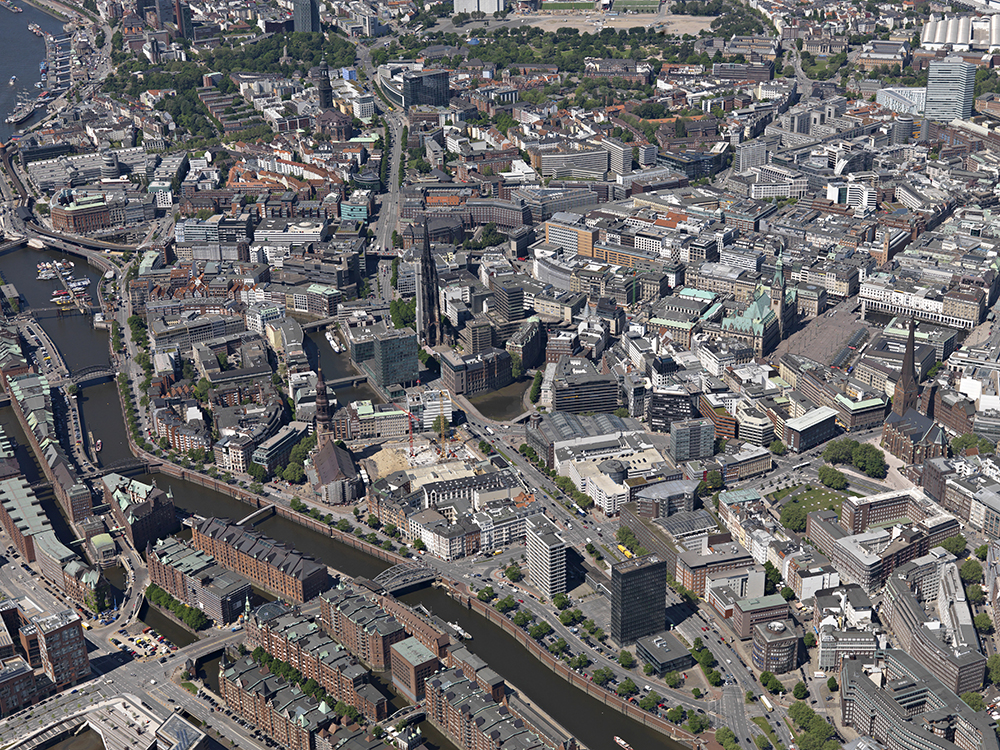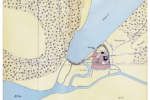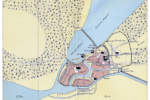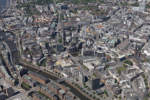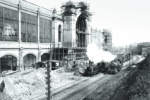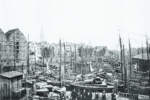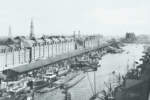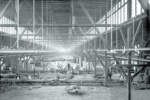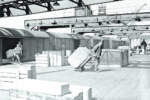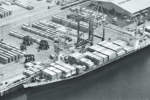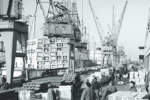Hamburg is said to have more bridges than Amsterdam and Venice combined; there seems to be 2123 of them. Perhaps water is no longer as omnipresent today in Hamburg as it is in Amsterdam or Venice, but the fact remains that the city owes its foundation, growth and importance to the Elbe, to the North Sea, to the Alster and other affluents. And it is just this great number of topographic elements that have given the city its unique character. There is, naturally, the Elbe with its emissaries, whose mouth is so close that it threatens the city itself with its floods. There is the Alster, which has been embanked and transformed into a small lake within the city, there are the flat marshlands with islands on the Elbe, the ridges of the Geest that form an elevated shore all the way to the Elbe, in the point where the valley formed by the melting of the great glaciers of the Ice Age terminates. Each of these elements has contributed to give the city its unique form, lending variety to its structure and plan.
Beginnings
The oldest traces of settlements date to the first Stone Age. Archaeological finds become more substantial as of the 4th and 7th century, but history was made in Hamburg already two centuries later. Emperor Charlemagne had extended his empire all the way to the Elbe. In 810 he had built a baptistery to christen the region. Hammaburg is mentioned for the first time in 831 as the residence of Archbishop Ansgar [Oscar], who gave Hamburg its name and who still today appears, in the form of a stylized icon, on the city’s coat of arms. But the city was not allowed to grow quietly and undisturbed; its position at the northern borders of the Empire was too insecure and exposed to changes.
By the year 1139 the city had been destroyed and rebuilt nine times. The urban area was initially located on the left bank of the Alster and on the Bille, not on the Elbe. In the year 1188 Wirad von Boizenburg founded a new commercial settlement on the right bank of the Alster, with a new harbour on what is today the Nikolaifleet. Legend has it that in the following year Emperor Frederick Barbarossa signed a letter of privilege guaranteeing the ships of Hamburg free navigation on the Elbe – it is a matter of a false document, a frequent occurrence at the time. But the citizens of Hamburg have not worried all that much about it, and the date is still celebrated as the birthday of the harbour. After a short intermezzo when the city was under Danish rule, during which the two settlements were unified, a great event took place in 1235: an embankment (today the Jungfernstieg) was built and the Alster dammed. The small lake which is today located inside the city, and which plays such an important role in the life of its inhabitants, was therefore created eight hundred years ago.
Hanseatic city and imperial city
It was precisely in the 13th century that Hamburg became what it has remained until this day, namely a city of exchange and trade. In 1321 it joined the League of Hanseatic cities of Northern Europe, soon assuming the role of principal trade centre. In 1510 Hamburg had become a free imperial city and in 1558 the first German stock exchange was opened. The discovery of America and the routes to the Far East definitively turned the city and its harbour into a gateway to the whole world.
In 1618 the citizens have made an enormous effort to make the city safer, by building a belt of fortifications. Thanks to the expansion and a profound transformation of the city, Hamburg remained immune from the devastations of the Thirty Years’ War (1618-1648) and was thus able to continue growing in the Baroque period; music and theatre flourished. The Napoleonic occupation (1806-1814) put an end to this splendid epoch. In 1815 Hamburg, having regained its freedom, joined the German League.
City of the world
In May 1842 the Hanseatic city faced a catastrophe with serious consequences. The “Great Fire” destroyed a part of the urban area and made 20,000 persons homeless. 1,700 dwellings, 102 warehouses, three churches and the town hall were devoured by the flames. However, as is often the case, this event which might have been expected to seal the fate of the city, on the contrary gave rise to a new beginning. The citizens of Hamburg used the event as an opportunity, giving the northern area of the city centre a new arrangement.
The large Baroque town walls were rebuilt. Two Fleete [canals] were filled in. New houses in classicist style were built.
As to the construction of the new town hall, the discussions went on for half a century, principally to establish in what architecture the building which was to represent the city was to be built. In 1886 the decision was made and in 1897 the great building in Neo-Renaissance style was opened, as one of the most majestic town halls of all Germany.
It was in this period that Hamburg became an active player on the international scene.
The inhabitants had tripled, reaching one million in 1900. As in all industrial cities, the urban area has been expanded and traffic systems and new infrastructures have been created. With the foundation of the German Reich in 1871 and the entry in the customs area, seafaring and international trade grew exponentially, to the point that also the harbour area kept expanding.
In 1881 one commenced the construction of the warehouse district, a harbour that was closed and excluded from customs, a fact which was to transform Hamburg into one of the world’s largest places for the storage and exchange of coffee, cocoa, spices and carpets. The warehouse district with its brick buildings and bourgeois romanticism inspired by the Middle Ages was to become the nucleus of a new urban development.
But above all, the harbour expanded to the southern shore of the Elbe and to the islands.
The building of the Nordostseekanal (1895) further increased the importance of the harbour, with its direct access route to the Ostsee and its connections to the German overseas colonies.
The harmony of bricks
Hamburg has enjoyed a long period of rapid growth, from the imperial age until the beginning of World War I in 1914. The city has acquired its characteristic appearance with the construction of numerous buildings as the central station, the Dammtor station built in art nouveau style, the Wasserturm of Sternschanze and the covered markets of Deichtor etc. Also the harbour has changed radically.
The jungle of thousands of masts and sails has disappeared, to be replaced by smoking funnels and hundreds of steel cranes. The front of the harbour with its piers, the roundabouts at the entrance to the tunnel across the Elbe, the shipping offices, the Institute of Tropical Medicine and the imposing monument to Bismarck have acquired the appearance they still have today, and have formed, along with the Alster lake located within the city and the town hall square, further landmarks giving the city its characteristic image.
At the end of the Empire and of World War I, in the face of new democratic conditions and a great shortage of housing, the new priority issue became the building of workers’ homes. A belt of residential districts was extended around the city core. One of the promoters of this consistent building activity, Fritz Schumacher – director of the department responsible for the construction of public buildings – designed more or less all the municipal schools and other infrastructures.
Due to the predominant use of bricks, it was possible to harmonize the different styles in use at the time – expressionism, traditional style, modern functionalism – creating harmonious districts. In the meanwhile the famous residential district of Kontor, with its expressionistic klinker facades and the grandiose Chilehaus as symbol, had appeared in the city centre.
The stroke of the bell
In the Hanseatic city the architectural phase of the national-socialist period following 1933 has left fewer traces than in many other German cities, in spite of the fact that Hamburg was considered one of the four “cities of the Führer”. The “Greater Hamburg” law of 1937, as a result of which the towns of Altona, Wandbek, Harburg-Weilhelmsburg and other small communities in the surroundings were united, has played an especially important role in the history of the city. During World War II Hamburg, which was the most important harbour city of Germany, was an important target of allied air raids. 50,000 inhabitants were killed, and whole areas of the city obliterated.
One half of the homes have been buried by rubble and dust. 80% of the harbour was destroyed.
After the war the city saw rapid growth and an economic miracle which resulted in the expansion of the shipyards and the development of the oil industry, the food and tobacco industry and the birth of a new German publishing centre. When the rubble had been removed and those buildings that could be saved had been repaired, the reconstruction began, from an architectural point of view, with a stroke of the bell: in the middle of the Herverstehude district, on a plot cleared of rubble, a group of 12 skyscrapers were erected: aligned parallelepipeds placed perpendicularly to the street in the radical architectural style of Ludwig Hilberseimer.
The residential districts built between 1946 and 1956 were signs of a changing atmosphere, which showed its effects also beyond the city of Hamburg.
Free circulation for cars
As to many of the new neighbourhoods and the garden cities in the surroundings of the city, the construction mode was essentially open, with large green areas. Now the programme consisted of a return to geometric principles of an order that had to embody the new structure of political power. The tendency consisted of arranging the streets organically, leaving some agricultural land between the buildings and allowing cars to circulate freely. Also the city centre was altered to make room for cars, for instance with the building of the Ost-West Strasse, a wide thoroughfare crossing the districts that had been destroyed. A sequence of buildings considered symbols of the economic recovery has been built along this street. It is a matter of free-standing buildings that do not merge particularly well into
the architectural structure of the city.
Another office district has also been built, the City Nord, a single-function aggregate of free-standing large buildings, made to measure for cars; only a few of them are convincing from an architectural point
of view.
In the Sixties large housing developments in the form of monotonous and mass-produced buildings have been erected also in the peripheral areas of Hamburg, before the trend turned in the Seventies and people began to prefer the urban vivacity of the city centre once again.
A project for the century
The reconstruction of the industry and the economy and, especially, the crisis of the shipyards have led to new architectural challenges. Large industrial areas have been liberated and are being redesigned and renovated. Standard-sized containers have revolutionized the shipping industry. The harbour has been moved eastward. Suddenly warehouses, old docks and even whole harbour areas have become available. The city is reaching for the harbour with the “string of pearls”, a sequence of office and apartment buildings along the banks of the Elbe which proceeds eastward from the Baumwall in the centre of the city all the way to Neumülen. Also the abandoned areas in the eastern parts of the harbour, from the old warehouse district to the bridges on the Elbe, have represented an opportunity for a great urbanistic plan. With the project of HafenCity, which looks to the new century, Hamburg is taking up new social challenges and responding to the demands for life and housing of those who live in the city in the age of the service society.
Falk Jaeger studied architecture and history of art at Braunschweig, Stuttgart and Tübingen. He worked 1983-88 for the Institute of History of Architecture at the Technical University of Berlin. From 1993 to 2000 he was appointed Chair of Theory of Architecture at the Technical University of Dresden. From 2001 until 2002, he was editor in chief of the German architecture magazine Bauzeitung. Today he is living in Berlin as a free lance journalist, editor and curator, working on architec-ture, theory and history of architecture for major newspapers, architecture maga-zines and radio stations.


